Family: Argidae
Family common name: argid sawflies
Subfamily: Sterictiphorinae
Genus: Sphacophilus Provancher, 1888
Subgenera: Sphacophilus, Ceocolus, Litocolus
Argidae are found in all non-polar regions of the world (Smith and Middlekauff 1987Smith and Middlekauff 1987:
Smith DR and Middlekauff WW. 1987. Suborder Symphyta. In: Stehr FW ed. Immature Insects. Kendall/Hunt Publishing Company. Vol. 1: 754 pp., Smith 1992Smith 1992:
Smith DR. 1992. A synopsis of the sawflies (Hymenoptera: Symphyta) of America south of the United States: Argidae. Memoirs of the American Entomological Society 39: 1-201.). They are external foliage feeders with a wide range of host plants. Additionally, the family exhibits some uncommon behaviors like the excretion of defensive compounds and subsocialsubsocial:
Living in aggregations but lacking organizational structure as in true social insects; can describes insects with tendencies to protect or care for thier young, feed gregariously, and build cocoon masses.
habits (Smith 1992Smith 1992:
Smith DR. 1992. A synopsis of the sawflies (Hymenoptera: Symphyta) of America south of the United States: Argidae. Memoirs of the American Entomological Society 39: 1-201.).
Sphacophilus are about 6–10 mm in length, and are generally orange and black in color. They are fairly speciosespeciose:
describing a taxon that includes a high number of species
and have an extensive range throughout the Americas. Although they have been classified into three separate subgenera, these groupings may be revised over time, as more species are discovered that do not fit the defined subfamilies (Smith 1971cSmith 1971c:
Smith DR. 1971c. Nearctic sawflies of the genera Neoptilia Ashmead, Schizocerella Forsius, Aprosthema Konow, and Sphacophilus Provancher (Hymenoptera: Argidae). Transactions of the American Entomological Society 97: 537-594., Smith 1992Smith 1992:
Smith DR. 1992. A synopsis of the sawflies (Hymenoptera: Symphyta) of America south of the United States: Argidae. Memoirs of the American Entomological Society 39: 1-201.).
There are 52 species described worldwide, all but one restricted to the Americas. The majority of species occur in North America, and the highest diversity is recorded in Central America and Mexico (Smith 1992Smith 1992:
Smith DR. 1992. A synopsis of the sawflies (Hymenoptera: Symphyta) of America south of the United States: Argidae. Memoirs of the American Entomological Society 39: 1-201., Taeger et al. 2010Taeger et al. 2010:
Taeger A, Blank SM, and Liston AD. 2010. World Catalog of Symphyta (Hymenoptera). Zootaxa 2580: 1-1064., Monjarás-Barrera et al. 2015, Smith 2017bSmith 2017b:
Smith DR. 2017b. A new Nearctic Sphacophilus Provancher (Hymenoptera: Argidae). Proceedings of the Entomological Society of Washington 119 (2): 228-232.).
A key to North American species of Sphacophilus is included in Smith 1971cSmith 1971c:
Smith DR. 1971c. Nearctic sawflies of the genera Neoptilia Ashmead, Schizocerella Forsius, Aprosthema Konow, and Sphacophilus Provancher (Hymenoptera: Argidae). Transactions of the American Entomological Society 97: 537-594..
 (Smith 1992Smith 1992:
(Smith 1992Smith 1992: less than width of cenchruscenchrus:
less than width of cenchruscenchrus: (Smith 1992Smith 1992:
(Smith 1992Smith 1992: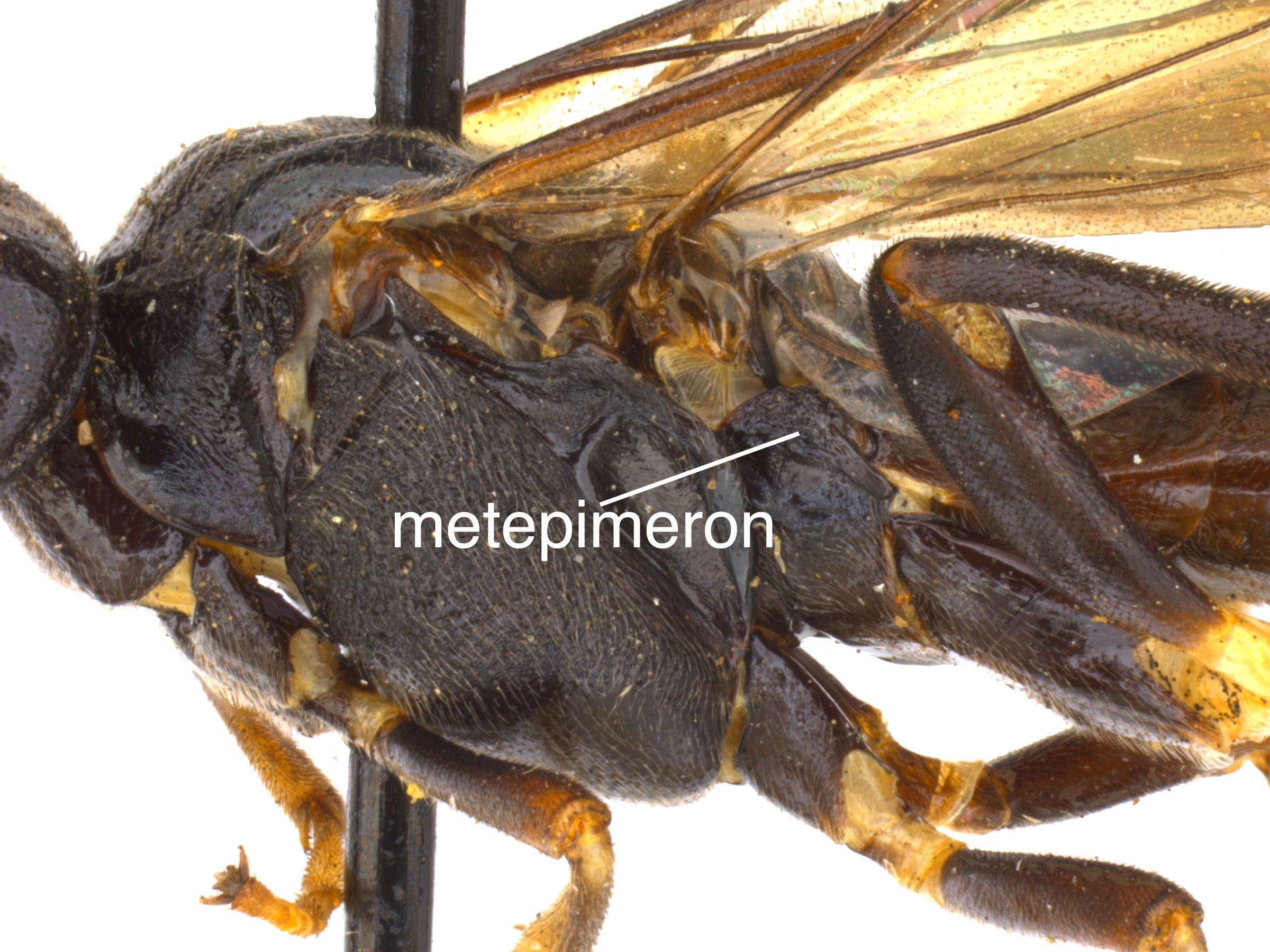 fused laterally with first tergitetergite:
fused laterally with first tergitetergite: (Smith 1992Smith 1992:
(Smith 1992Smith 1992: R open at apexapex:
R open at apexapex: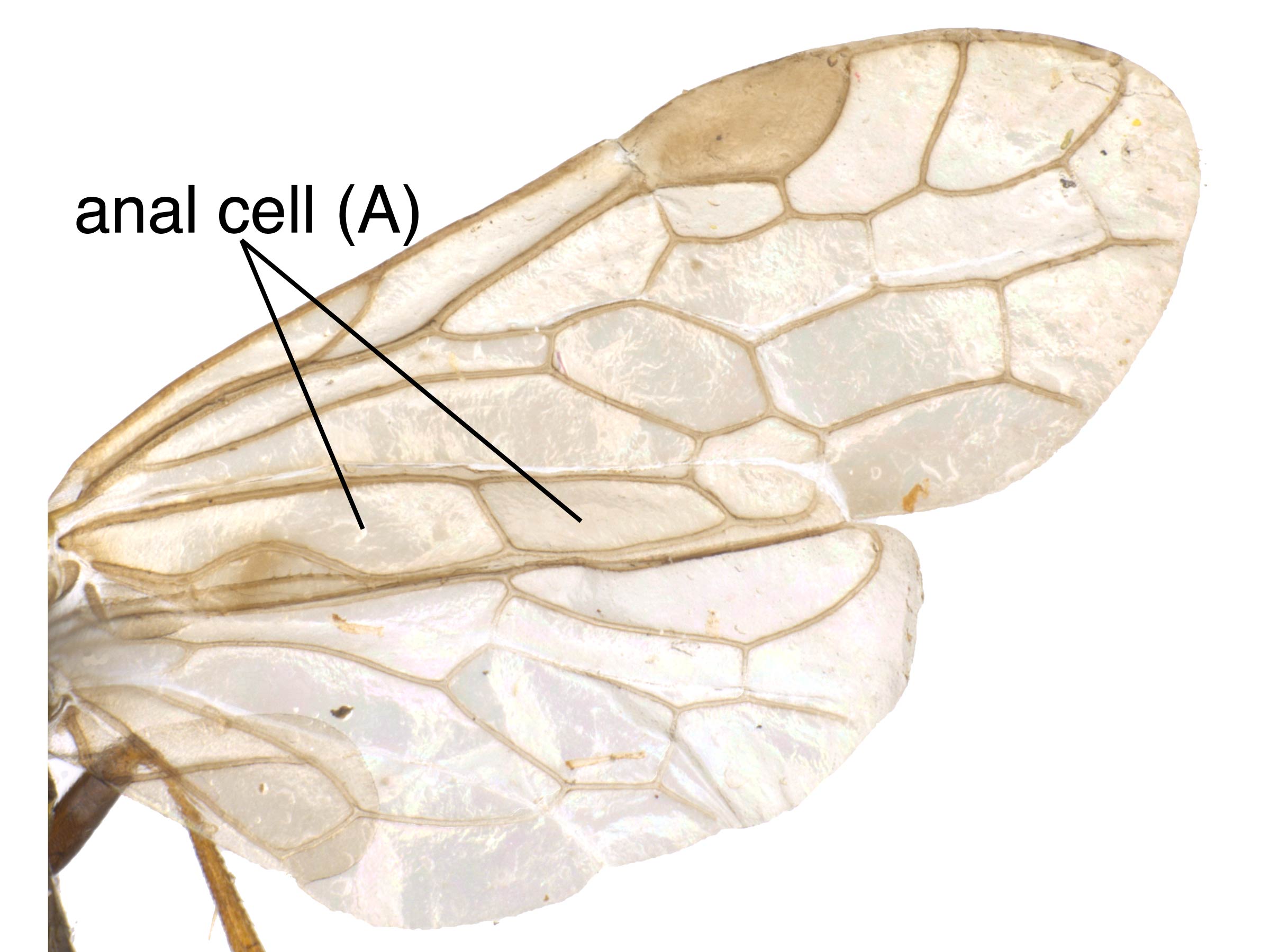 of hind winghind wing:
of hind winghind wing: present (Smith 1992Smith 1992:
present (Smith 1992Smith 1992: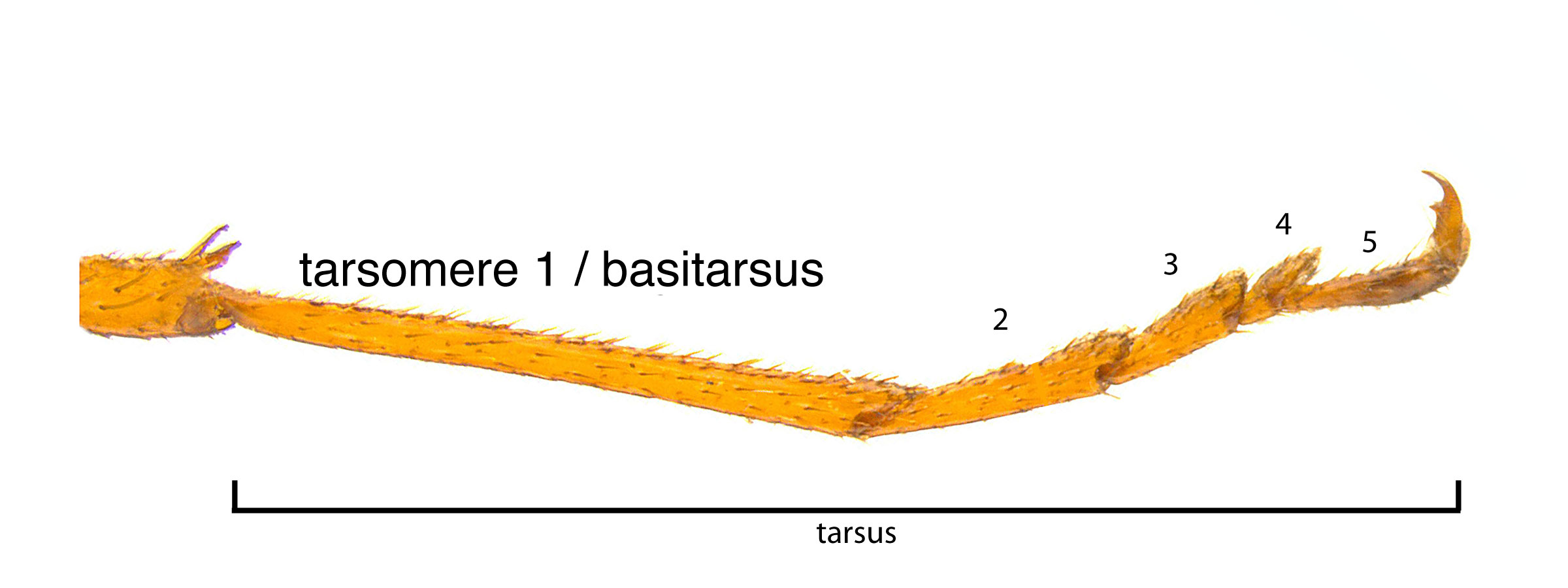 usually shorter than remaining tarsitarsus:
usually shorter than remaining tarsitarsus: combined (Smith 1992Smith 1992:
combined (Smith 1992Smith 1992: simple (Smith 1992Smith 1992:
simple (Smith 1992Smith 1992:The family Argidae can be distinguished from other sawflies by the single-segmented flagellumflagellum:
the third section of the antennae that includes all the segments beyond the pedicel; segments of the flagellum are known as flagellomeres
 of the antennaantenna:
of the antennaantenna:
the sensory organ emerging from the front of the head, usually between the compound eyes and above the clypeus; includes the flagellum, scape and pedicel
 . The genus Sphacophilus can be distinguished from other genera in the family by the wing venationvenation:
. The genus Sphacophilus can be distinguished from other genera in the family by the wing venationvenation:
the network of veins on a wing
, palpipalpus:
jointed structures emerging from the labium and maxilla
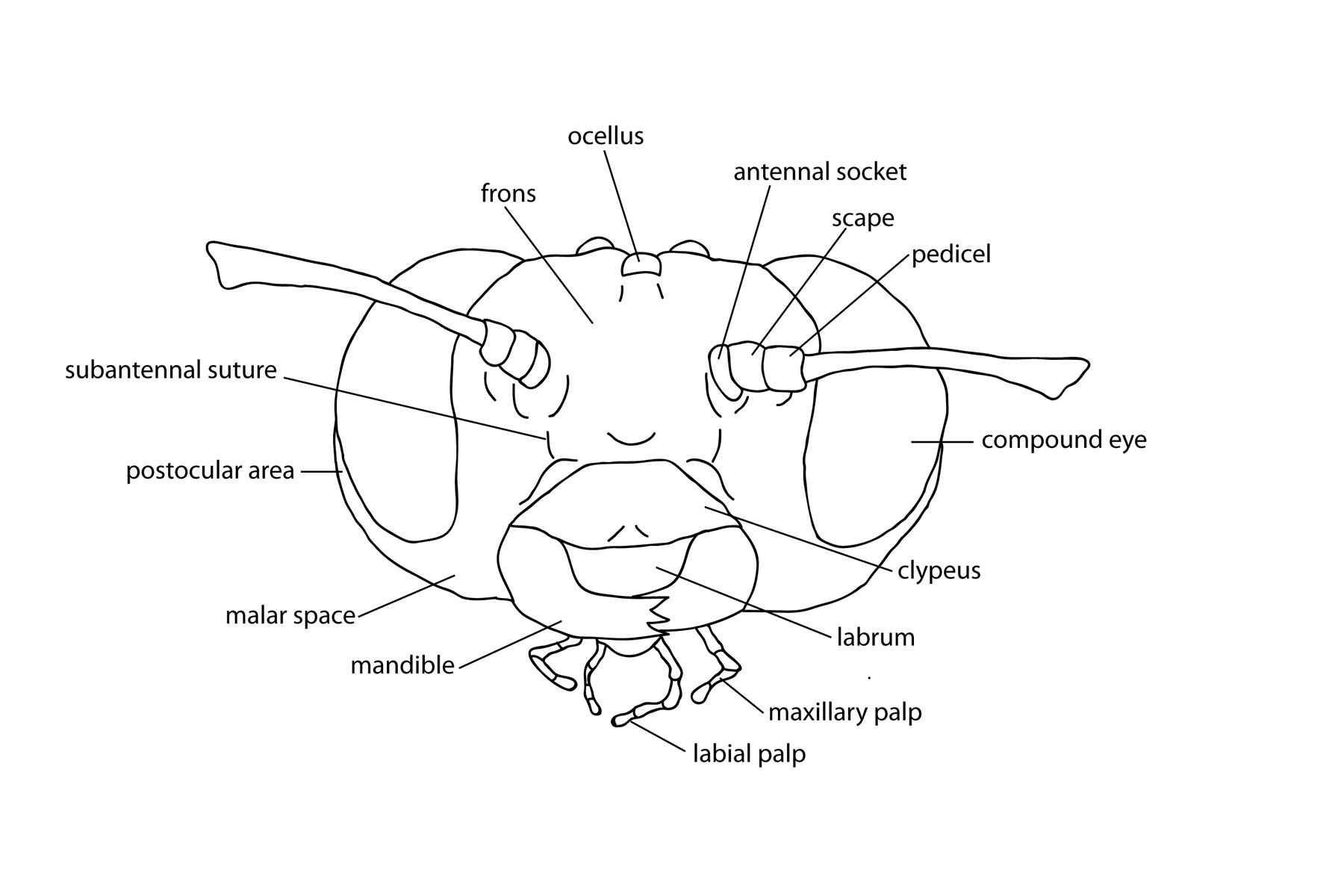 length, lack of veinvein:
length, lack of veinvein:
a tube-like, often darkened, structure on the wings
 Sc, and a lack of preapicalpreapical:
Sc, and a lack of preapicalpreapical:
close to, but anterior to, the apex
 tibial spurs. Males are distinguished from related genera Arge and Atomacera by the conspicuous forked antennaeantenna:
tibial spurs. Males are distinguished from related genera Arge and Atomacera by the conspicuous forked antennaeantenna:
the sensory organ emerging from the front of the head, usually between the compound eyes and above the clypeus; includes the flagellum, scape and pedicel
 (Smith 1992Smith 1992:
(Smith 1992Smith 1992:
Smith DR. 1992. A synopsis of the sawflies (Hymenoptera: Symphyta) of America south of the United States: Argidae. Memoirs of the American Entomological Society 39: 1-201.).
Sphacophilus monjarasi is an agricultural pest in southern Mexico and Central America, where it feeds on a regionally important food crop, Crotalaris longirostrata, commonly known as chipilín. Chipilín is also grown in some regions of the United States (Monjarás-Barrera et al. 2015).
Many species have been observed as external leaf feeders on a large variety of trees and shrubs from the Fabaceae and Convolvulaceae. Confirmed genera include Ipomoea (morning glory), Convolvulus (bindweed), Psoralea, Desmodium (tick clover), and Delea (prairie clover). One species in Costacosta:
the robust vein on the anterior margin of the wing; vein C
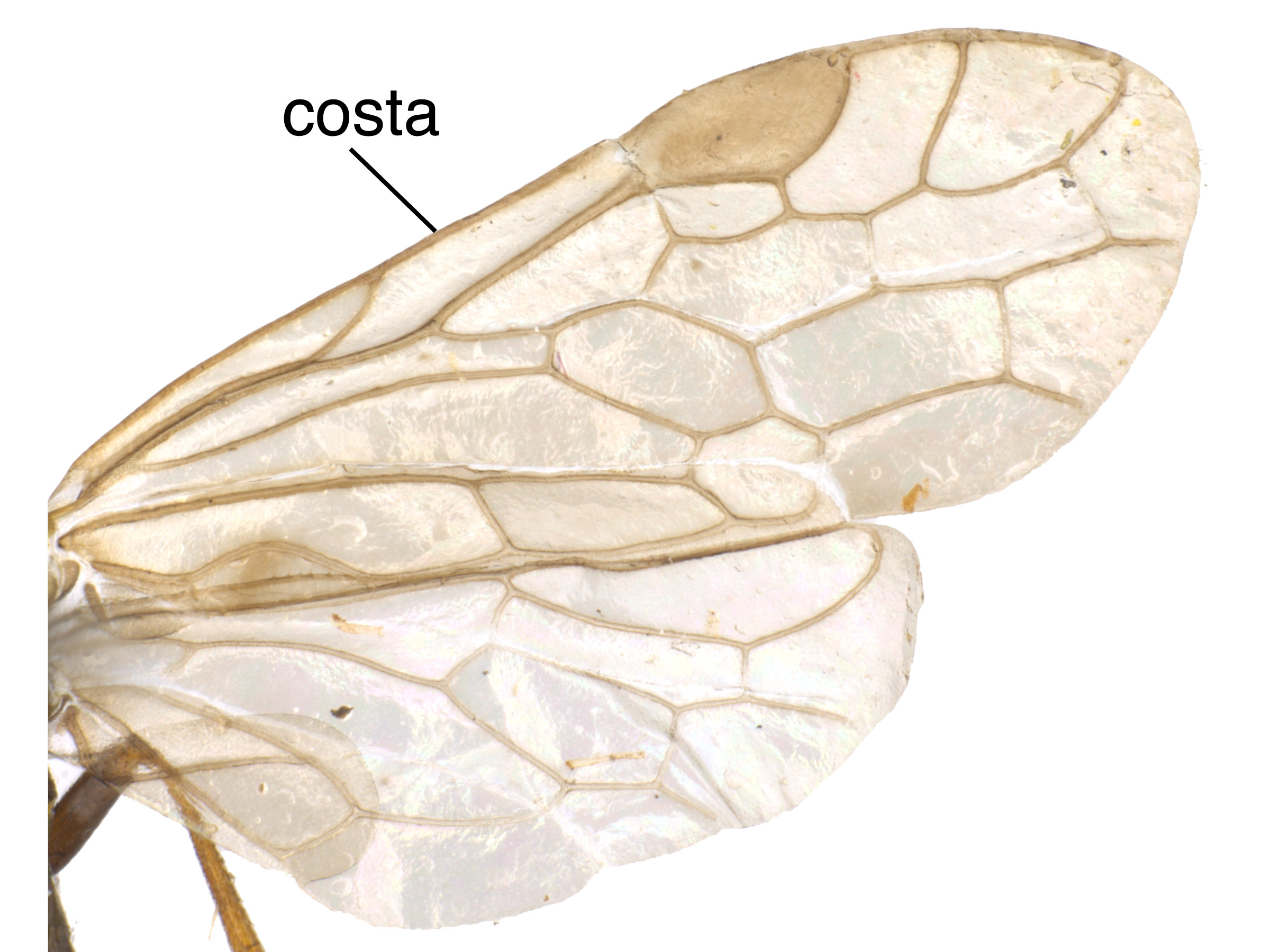 Rica is known from Fabaceae Hymenaea courbaril (West Indian Locust), another from Malpighiaceae Heteropterys laurifolia (dragon withe), and one species in the southwestern United States has been reared from Polygonaceae species Eriogonum wrightii (bastardsage) (Smith and Middlekauff 1987Smith and Middlekauff 1987:
Rica is known from Fabaceae Hymenaea courbaril (West Indian Locust), another from Malpighiaceae Heteropterys laurifolia (dragon withe), and one species in the southwestern United States has been reared from Polygonaceae species Eriogonum wrightii (bastardsage) (Smith and Middlekauff 1987Smith and Middlekauff 1987:
Smith DR and Middlekauff WW. 1987. Suborder Symphyta. In: Stehr FW ed. Immature Insects. Kendall/Hunt Publishing Company. Vol. 1: 754 pp., Smith 1992Smith 1992:
Smith DR. 1992. A synopsis of the sawflies (Hymenoptera: Symphyta) of America south of the United States: Argidae. Memoirs of the American Entomological Society 39: 1-201., Smith and Janzen 2003Smith and Janzen 2003:
Smith DR and Janzen DH. 2003. Food plants and life histories of sawflies of the family Argidae (Hymenoptera) in Costa Rica, with descriptions of two new species. Journal of Hymenoptera Research 12 (1): 193-203.). Sphacophilus apios feeds on Apios americana (potato bean) (Ross 1933Ross 1933:
Ross HH. 1933. The description and life history of a new sawfly, Sterictiphora apios (Argidae: Hymen.). Proceedings of the Entomological Society of Washington 35 (2): 13-19., Taeger et al. 2010Taeger et al. 2010:
Taeger A, Blank SM, and Liston AD. 2010. World Catalog of Symphyta (Hymenoptera). Zootaxa 2580: 1-1064.). Important agricultural host records include Sphacophilus cellularis feeding on Ipomoea batatas (sweet potato), and Sphacophilus monjarasi on Crotalaria longirostrata (chipilín) (Smith 1971cSmith 1971c:
Smith DR. 1971c. Nearctic sawflies of the genera Neoptilia Ashmead, Schizocerella Forsius, Aprosthema Konow, and Sphacophilus Provancher (Hymenoptera: Argidae). Transactions of the American Entomological Society 97: 537-594., Monjarás-Barrera et al. 2015). The host for many species is unknown (Monjarás-Barrera et al. 2015).
Larvaelarva:
the immature stage of holometabolous insects
 are only known for 3 NearcticNearctic:
are only known for 3 NearcticNearctic:
describing the region of the Northern Hemisphere that includes North America south through northern Mexico
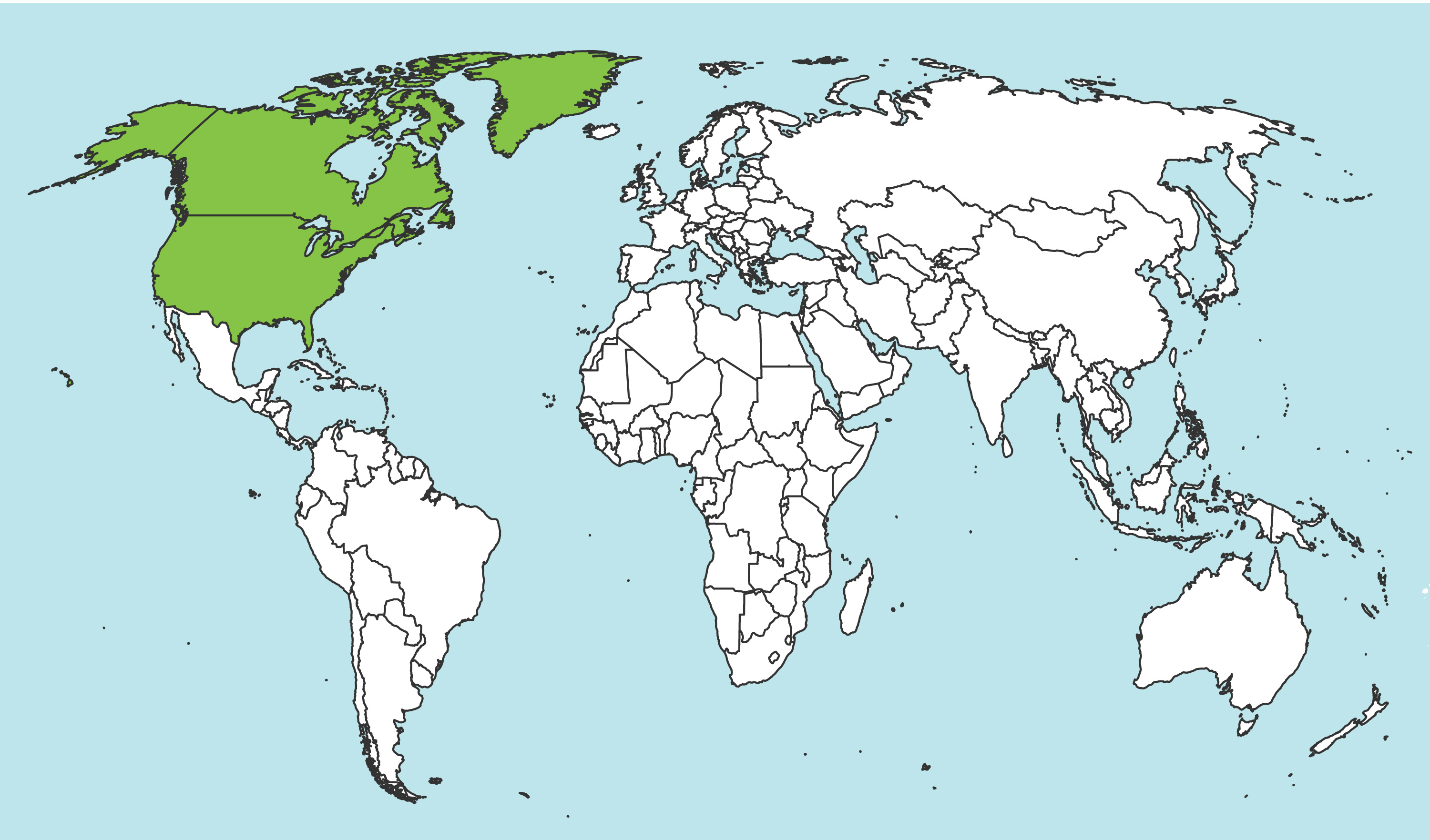 species (S. cellularis, S. nigriceps, S. apios). All three species have black or brown head capsules with black spots around the ocelliocellus:
species (S. cellularis, S. nigriceps, S. apios). All three species have black or brown head capsules with black spots around the ocelliocellus:
a simple bead-like eye, often on the dorsum of the head in groups of 1-3
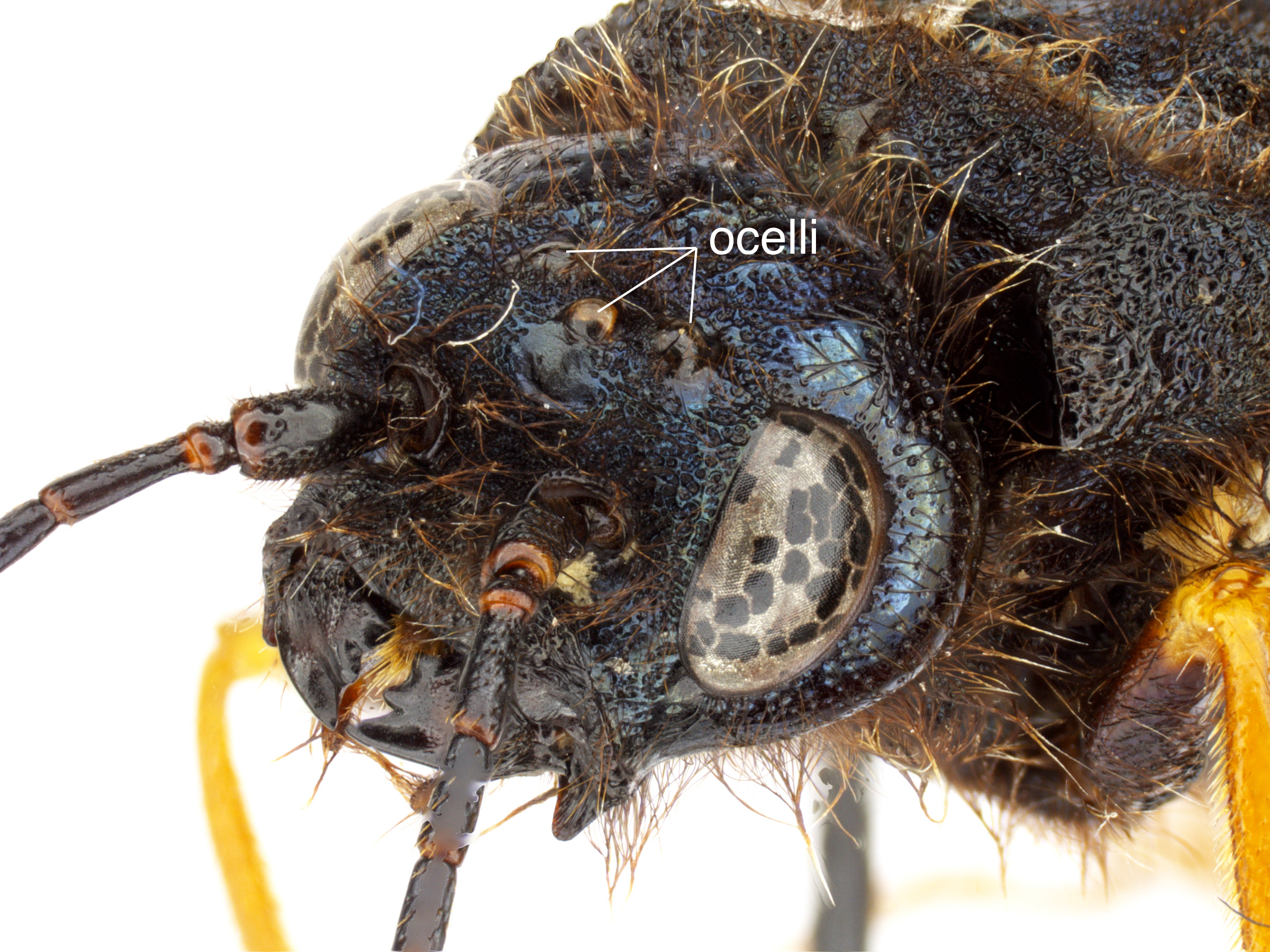 and on the apexapex:
and on the apexapex:
the end or most distal area of any structure
of the mandiblemandible:
the primary mouthpart used for biting and chewing; jaw
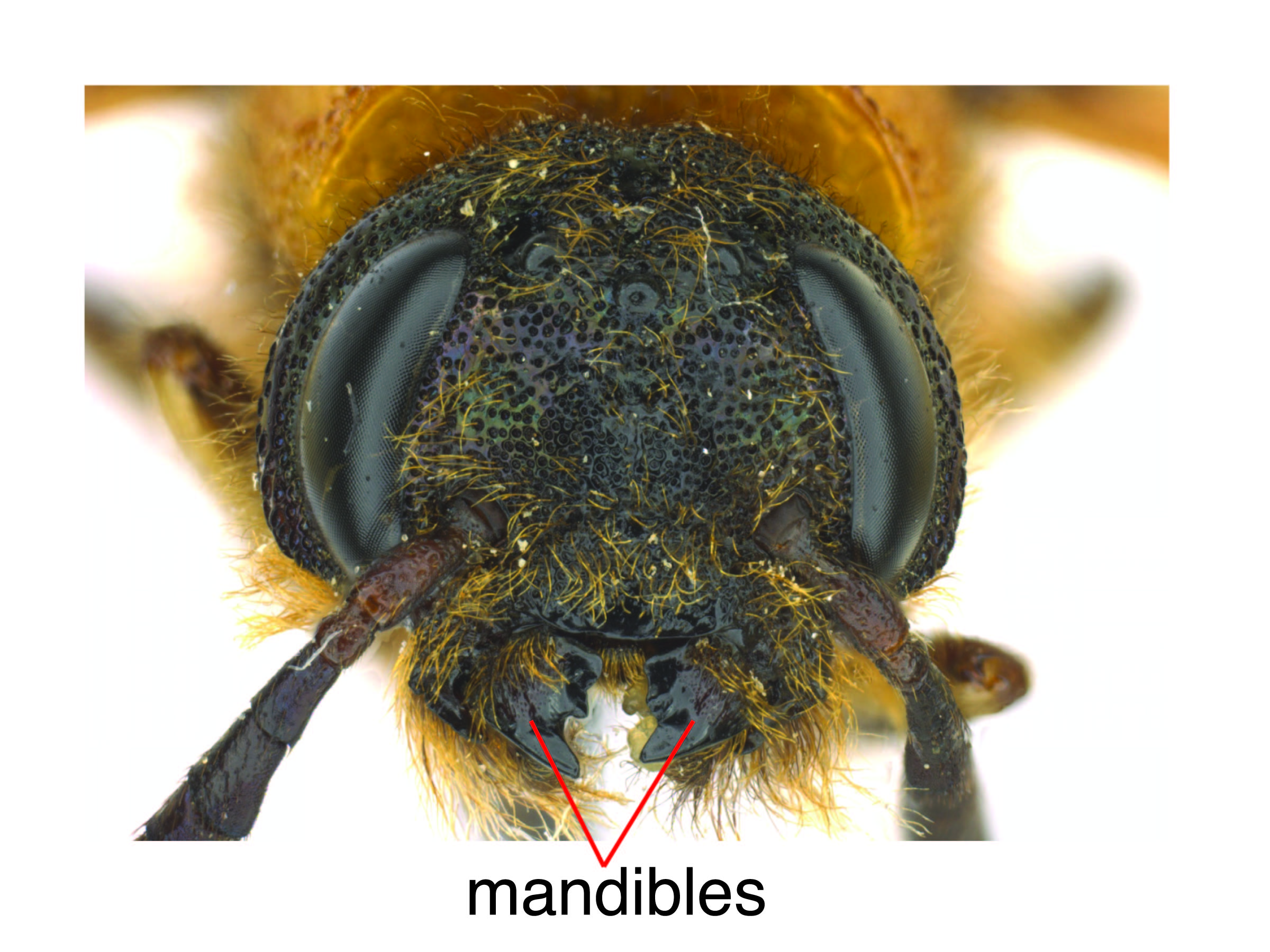 , and green bodies with short dark-colored tubercles throughout and a set of long spines at the apexapex:
, and green bodies with short dark-colored tubercles throughout and a set of long spines at the apexapex:
the end or most distal area of any structure
of the abdomenabdomen:
the third and last segment of an insect's body; in sawflies this is usually made up of 11 segments (segments 9 and 10 often fused)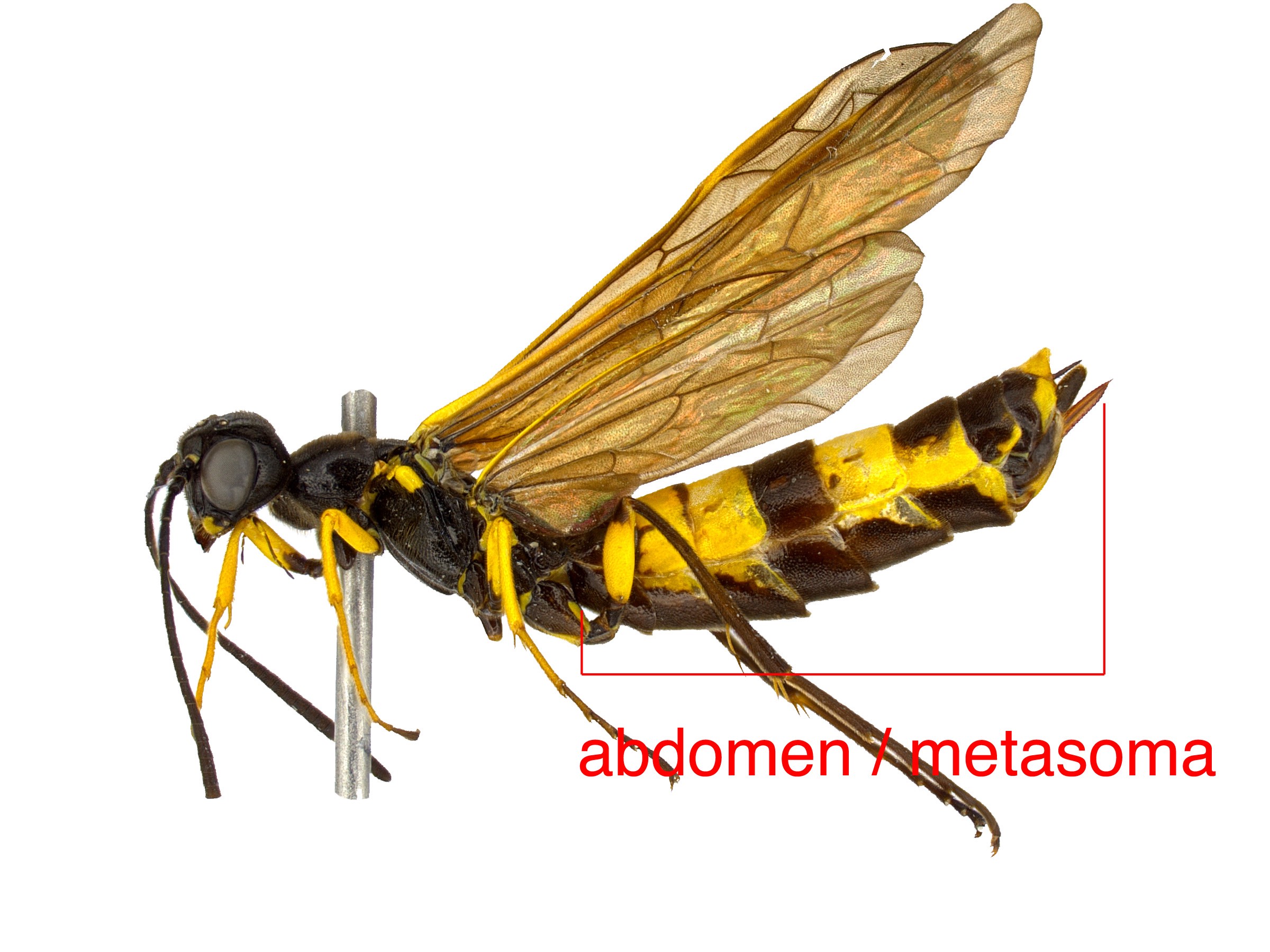 (Ross 1933Ross 1933:
(Ross 1933Ross 1933:
Ross HH. 1933. The description and life history of a new sawfly, Sterictiphora apios (Argidae: Hymen.). Proceedings of the Entomological Society of Washington 35 (2): 13-19., Smith 1972Smith 1972:
Smith DR. 1972. North American sawfly larvae of the family Argidae (Hymenoptera). Transactions of the American Enotomolocial Society 98: 163-184., BugGuide 2019BugGuide 2019:
BugGuide. Accessed January 2019. https://bugguide.net).
Scattered records from Central America provide some information on larval habits. Small green larvaelarva:
the immature stage of holometabolous insects
 of S. janzeni feed on new leaf growth of young plants in a semi-circular pattern, and build brown oval cocoons that they attach to leaf fragments or stems in the leaf litter. Sphacophilus manjarasi has similar habits, but builds its cocoon on the still-standing, defoliated stem of the plant. Species reared from tropical regions in Central America do not undergo dormancy or diapausediapause:
of S. janzeni feed on new leaf growth of young plants in a semi-circular pattern, and build brown oval cocoons that they attach to leaf fragments or stems in the leaf litter. Sphacophilus manjarasi has similar habits, but builds its cocoon on the still-standing, defoliated stem of the plant. Species reared from tropical regions in Central America do not undergo dormancy or diapausediapause:
a non-active period of no development; sawflies often enter diapause as a prepupa or pupa to overwinter
, and eclose after just 1–2 weeks as a pupapupa:
the intermediate and inactive life stage of holometabolous insects, between larva and adult
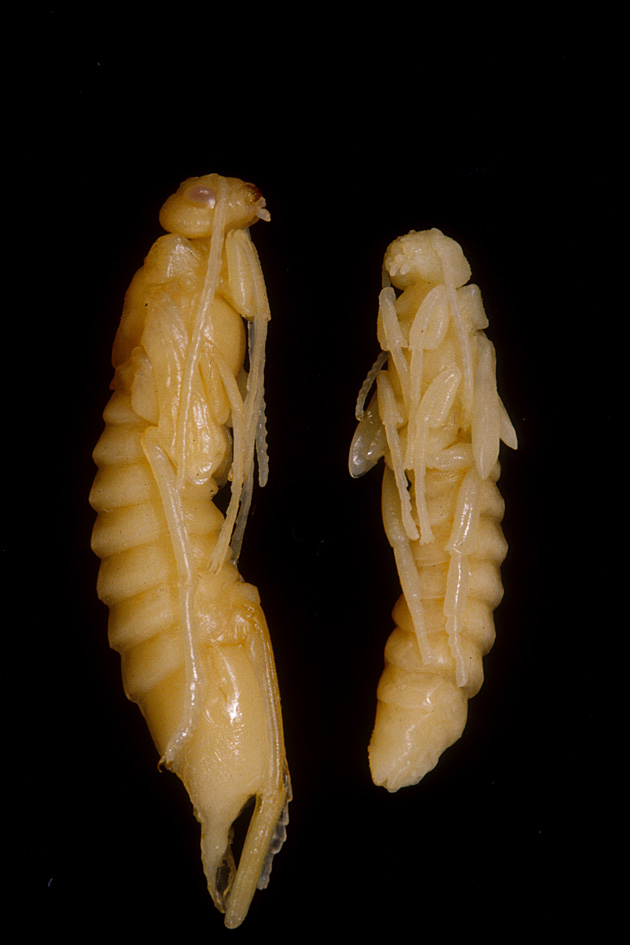 (Smith and Janzen 2003Smith and Janzen 2003:
(Smith and Janzen 2003Smith and Janzen 2003:
Smith DR and Janzen DH. 2003. Food plants and life histories of sawflies of the family Argidae (Hymenoptera) in Costa Rica, with descriptions of two new species. Journal of Hymenoptera Research 12 (1): 193-203., Monjarás-Barrera et al. 2015).
World: This genus ranges from as far north as Canada, as far south as Bolivia (Smith 1992Smith 1992:
Smith DR. 1992. A synopsis of the sawflies (Hymenoptera: Symphyta) of America south of the United States: Argidae. Memoirs of the American Entomological Society 39: 1-201., Smith 2017bSmith 2017b:
Smith DR. 2017b. A new Nearctic Sphacophilus Provancher (Hymenoptera: Argidae). Proceedings of the Entomological Society of Washington 119 (2): 228-232.). One species, Sphacophilus afer, is recorded from tropical Africa (Cameroon) (Liston et al. 2017).
North America: Sphacophilus ranges from southern Canada, south through the United States, Mexico, and Central America. There are no records in the Caribbean Islands (Smith 1992Smith 1992:
Smith DR. 1992. A synopsis of the sawflies (Hymenoptera: Symphyta) of America south of the United States: Argidae. Memoirs of the American Entomological Society 39: 1-201.).
Map data from: GBIF.org (26 June 2019) GBIF Occurrence Download Sphacophilus
Details about data used for maps can be found here.